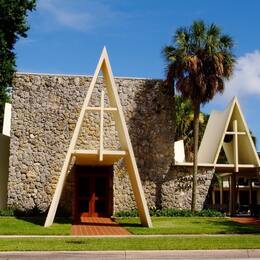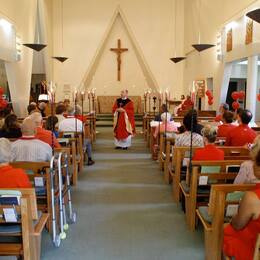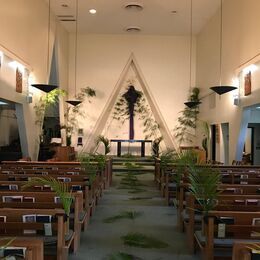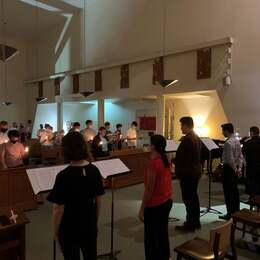Denomination: Episcopal Church
St. Bede Chapel, the Episcopal Church Center at the University of Miami, is a place where progressive Christianity and traditional worship meet. An outreach of The Episcopal Church, we are here to serve any and all students, regardless of your particular religious tradition (or lack thereof). The word "Episcopal" describes what we have to offer; it in no way is intended to limit whom we serve.
About Our Worship
"Eucharist" is a Greek word meaning "thanksgiving." The celebration of the Eucharist is our weekly act of giving thanks to God for our creation, for our lives, for the gift of revelation, and for God's love for us as expressed in the life, death, and resurrection of Jesus Christ. Jesus instituted the Eucharist at his Last Supper with his disciples the night of his arrest. The Last Supper was a Passover Seder. At one point during the dinner, Jesus took the unleavened matzah and said, "This is my body, given for you." He did the same to one of the ritual cups of wine (the fourth?), saying, "This is my blood of the new covenant which is shed for you and for all for the forgiveness of sins. Drink this, all of you. Do this in memory of me." Jesus asked us to "do this in [his] memory," so we do. From the very founding of Christianity, the celebration of the Eucharist has been the primary worship of the Church.
Our worship is very biblically based. In common with Roman Catholics, Lutherans, Methodists, and others, we follow a three-year cycle of readings. The usual pattern is as follows: 1. an Old Testament reading; 2. a Psalm or Psalm portion; 3. a New Testament reading (usually from one of the Letters, of Paul or of someone else); 4. a reading from the Gospels (which of course are also from the New Testament). In the three-year cycle, The Gospel according to Matthew is read in Year A, Mark in Year B, and Luke in Year C. The Fourth Gospel, that according to John, does not have a year assigned to it, but John appears at different times in all three years.
The Scripture readings are followed by a sermon. Then we recite an affirmation of faith, usually the Nicene Creed, though at our Sunday night student service we use a modern re-working of that creed that was developed by the Church in New Zealand. After the Creed comes the Prayers of the Faithful, a general Confession of Sin, the Passing of the Peace, and then the Eucharistic Prayer in which the bread and wine are consecrated. Once we've shared communion there's not much more left: a final prayer and a final hymn, then a dismissal to go out into the world to love and serve the Lord.
About Our Worship
"Eucharist" is a Greek word meaning "thanksgiving." The celebration of the Eucharist is our weekly act of giving thanks to God for our creation, for our lives, for the gift of revelation, and for God's love for us as expressed in the life, death, and resurrection of Jesus Christ. Jesus instituted the Eucharist at his Last Supper with his disciples the night of his arrest. The Last Supper was a Passover Seder. At one point during the dinner, Jesus took the unleavened matzah and said, "This is my body, given for you." He did the same to one of the ritual cups of wine (the fourth?), saying, "This is my blood of the new covenant which is shed for you and for all for the forgiveness of sins. Drink this, all of you. Do this in memory of me." Jesus asked us to "do this in [his] memory," so we do. From the very founding of Christianity, the celebration of the Eucharist has been the primary worship of the Church.
Our worship is very biblically based. In common with Roman Catholics, Lutherans, Methodists, and others, we follow a three-year cycle of readings. The usual pattern is as follows: 1. an Old Testament reading; 2. a Psalm or Psalm portion; 3. a New Testament reading (usually from one of the Letters, of Paul or of someone else); 4. a reading from the Gospels (which of course are also from the New Testament). In the three-year cycle, The Gospel according to Matthew is read in Year A, Mark in Year B, and Luke in Year C. The Fourth Gospel, that according to John, does not have a year assigned to it, but John appears at different times in all three years.
The Scripture readings are followed by a sermon. Then we recite an affirmation of faith, usually the Nicene Creed, though at our Sunday night student service we use a modern re-working of that creed that was developed by the Church in New Zealand. After the Creed comes the Prayers of the Faithful, a general Confession of Sin, the Passing of the Peace, and then the Eucharistic Prayer in which the bread and wine are consecrated. Once we've shared communion there's not much more left: a final prayer and a final hymn, then a dismissal to go out into the world to love and serve the Lord.








